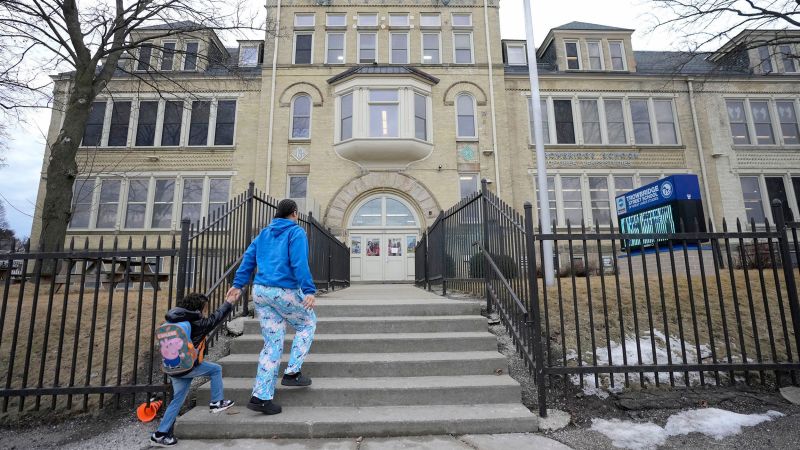The city of Milwaukee is currently facing a significant public health crisis concerning elevated lead levels in the blood of some students, primarily due to the presence of lead in its aging school buildings. In light of this crisis, the Milwaukee Public School District has taken decisive steps, including the temporary closure of two additional school facilities: Westside Academy and Brown Street School. With these closures, the total count of closed elementary schools now reaches four, which also includes Starms Early Childhood Education Center and LaFollette School. Overall, measures are being initiated at nine schools this year as officials prioritize addressing the lead hazards.
The immediate concern stems from the identification of lead in flaking and chalking paint of older school buildings, which has been linked to raised blood lead levels in at least four students during the current school year. In response, the Milwaukee school district, alongside the city’s health department, is undertaking inspections of roughly 100 buildings constructed before 1978. This year marks a proactive approach, with Superintendent Brenda Cassellius aiming to clean schools built prior to 1950 before the next academic year begins, and expecting to address an additional 52 schools built between 1950 and 1978 before the year’s end.
Superintendent Cassellius emphasizes the importance of family engagement in safeguarding children’s health, as she encourages parents to have their children tested for lead exposure through their family doctors or at community-organized clinics. The health implications of lead exposure, particularly for children, are severe and well-documented; it poses significant neurotoxic risks and can disrupt a child’s development, leading to learning disabilities, behavioral issues, and various acute symptoms.
To systematically combat the lead crisis, the district has implemented a structured plan for assessing and remediating the risks in schools. This procedure begins with a thorough visual inspection of each building. Based on these assessments, schools will be classified into risk categories—low, medium, or high—and those categorized as medium to high risk will undergo additional testing and may necessitate full or partial closures for lead remediation efforts. Notably, the plan also seeks to evaluate potential lead exposure for staff, such as custodians.
Despite these proactive steps, Milwaukee is encountering challenges in effectively screening students for lead exposure. Previously, the city worked in conjunction with the U.S. Centers for Disease Control and Prevention (CDC) to strategize testing; however, funding cuts to the CDC’s lead poisoning prevention program have significantly hampered local efforts. The city’s requests for support from the CDC, including temporary epidemiologist assistance through the EpiAid program, have been declined due to these financial constraints.
In a recent letter, Wisconsin Senator Tammy Baldwin and Representative Gwen Moore have urged the U.S. Department of Health and Human Services to restore the CDC’s lead specialists to aid Milwaukee in resolving its lead exposure issues. They pointedly requested immediate action from Health Secretary Robert F. Kennedy Jr., highlighting their recognition of the urgency of this public health matter.
The lead crisis surfaced after a child tested positive for high blood lead levels late last year; subsequent investigations uncovered environmental factors—specifically, peeling lead paint in the school environment—as potential sources of the exposure. Milwaukee’s history with lead-related health issues is troubling, especially in areas where a substantial percentage of children have historically tested positive for elevated lead levels. However, this current situation marks a novel occurrence as the correlation between lead poisoning and schools has not been documented in the past.
The longstanding issue of lead exposure primarily originates from the decay of lead paint found in older homes and buildings, including schools. This has been exasperated by the school district’s failure to maintain upkeep and apply protective paint layers effectively over time. A report previously indicated over $265 million in deferred maintenance costs that the district has yet to address. Meanwhile, health officials are cautiously monitoring additional reported cases of elevated blood lead levels among students, emphasizing the necessity of distinguishing between exposure sources, whether they stem from home environments or school facilities.
To mitigate the ongoing exposure risk, the health department is investigating the nature of lead exposure—both acute and chronic—and considering the possibility of adjusting screening guidelines to include older children in lead testing. School-based lead testing clinics have been initiated to facilitate easier access for families, with further efforts aimed at continuing these screenings despite the setback of resources.
The Milwaukee public health crisis serves as a critical reminder of the enduring legacy of lead exposure in urban environments and the need for resolute action in managing public health threats. As students continue to navigate the repercussions of the lead crisis, the collaborative efforts of the community, health officials, and governmental representatives will be vital in addressing and rectifying this serious public health concern.



